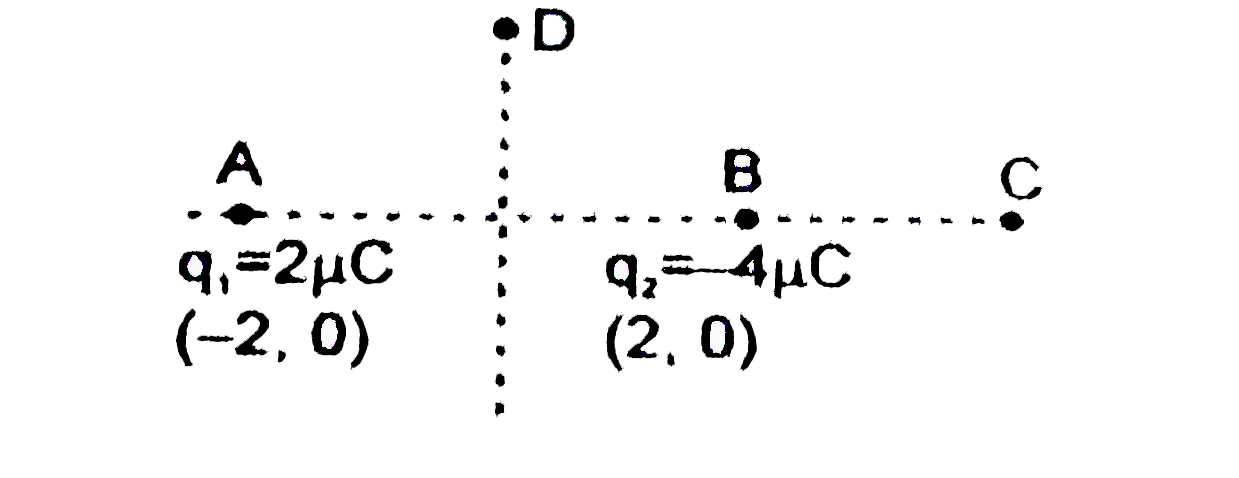An electric charge 10−3μC is placed at the origin (0, 0) of X-Y co-ordinate system. Two points A and B are situated at (√2,√2) and (2, 0) respectively. The potential difference between the points A and B will be
(a) 4.5 volts
(b) 9 volts
(c) zero
(d) 2 volt
The correct Answer is:C
To find the potential difference between points A and B due to a charge q=10−3μC placed at the origin (0, 0), we can follow these steps:
Step 1: Understand the positions of points A and B
- Point A is located at (√2,√2).
- Point B is located at (2,0).
Step 2: Calculate the distances from the charge to points A and B
- The distance from the origin to point A, rA, can be calculated using the distance formula:
rA=√(√2−0)2+(√2−0)2=√2+2=√4=2
- The distance from the origin to point B, rB, is simply:
rB=√(2−0)2+(0−0)2=√4=2
Step 3: Calculate the electric potential at points A and B
The electric potential V due to a point charge is given by the formula:
V=14πϵ0⋅qr
where q is the charge and r is the distance from the charge.
- For point A:
VA=14πϵ0⋅10−3×10−62
- For point B:
VB=14πϵ0⋅10−3×10−62
Step 4: Calculate the potential difference ΔV
The potential difference ΔV between points A and B is given by:
ΔV=VB−VA
Since both potentials VA and VB are equal (as they are both calculated at the same distance from the charge), we have:
ΔV=0
Final Answer
The potential difference between points A and B is 0.
---
- Point A is located at (√2,√2).
- Point B is located at (2,0).
- The distance from the origin to point A, rA, can be calculated using the distance formula:
rA=√(√2−0)2+(√2−0)2=√2+2=√4=2
- The distance from the origin to point B, rB, is simply:
rB=√(2−0)2+(0−0)2=√4=2
The electric potential V due to a point charge is given by the formula:
V=14πϵ0⋅qr
where q is the charge and r is the distance from the charge.
VA=14πϵ0⋅10−3×10−62
VB=14πϵ0⋅10−3×10−62
The potential difference ΔV between points A and B is given by:
ΔV=VB−VA
Since both potentials VA and VB are equal (as they are both calculated at the same distance from the charge), we have:
ΔV=0
The potential difference between points A and B is 0.
Topper's Solved these Questions
- ELECTROSTATICSBOOK - SUNIL BATRA (41 YEARS IITJEE PHYSICS)CHAPTER - ELECTROSTATICSEXERCISE - Subjective Problems
2 Videos
- ELECTROSTATICSBOOK - SUNIL BATRA (41 YEARS IITJEE PHYSICS)CHAPTER - ELECTROSTATICSEXERCISE - Comprehension Based Questions
2 Videos
- ELECTROMAGNETIC INDUCTION AND ALTERNATING CURRENTBOOK - SUNIL BATRA (41 YEARS IITJEE PHYSICS)CHAPTER - ELECTROMAGNETIC INDUCTION AND ALTERNATING CURRENTEXERCISE - JEE Main And Advanced
107 Videos
- MODERN PHYSICSBOOK - SUNIL BATRA (41 YEARS IITJEE PHYSICS)CHAPTER - MODERN PHYSICSEXERCISE - MCQ (One Correct Answer
1 Videos
Similar Questions
Knowledge Check
An electric charge 10−3μC is placed at the origin (0,0) of x-y coordinate system. Two points A and B are situated at (√2,√2) and (2,0) respectively. The potential difference between the points A and B will be
AzeroB9VC4.5 VD2VA charge of 10μC is placed at the origin of x-y coordinate system. The potnetial difference between two point (0, a) and (a, 0) in volt will be
A9×10−4aB9×1048√2C9x1042aDzeroAn isotropic point source 'S' of sound emits constant power. Two points A and B are situated at distance x and 2x from S. the difference between the loudness of points A and B is about (log 2=0.3)
A3 dBB2 dBC6 dBD12 dB
If the co-ordinates of two point A and B are (√7,0) and (−√7,0) respectively and P is any point on the curve 9x2+16y2=144, then find AP+PB.
View Solutiontwo point charges 2μC and −4μC are situated at points (−2m,0m) and (2m,0m) respectively. Find out potential at point C(4m,0m) and D(0m,√5m).

View SolutionTwo point charges 8 μC and −8μC are kept at points (-2cm, 0) and (2cm, 0), respectively. Calculate the electric potential at points (0, 7cm) and (4cm, 0).
View SolutionA point charge of 0.009μC is placed at origin.
Calculate intensity of electric field due to this point charge at point (√2,√7,0).
View SolutionTwo point charges −q and +q/2 are situated at the origin and the point (a,0,0) respectively. The point along the X-axis where the electric field Vanishes is
View Solution
